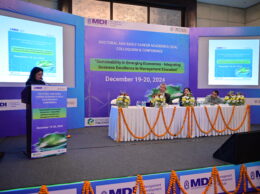Kolkata, India – A ground-breaking study led by Prof. Jayanarayanan Kuttippurath from the Centre for Ocean, River, Atmosphere and Land Sciences (CORAL) at the Indian Institute of Technology Kharagpur (IIT-Kharagpur), in collaboration with international researchers, has refuted previous claims of a severe ozone hole in the tropical stratosphere. The study provides reassurance that there is no significant ozone depletion in the tropics and no associated health threat.
The recent study entitled “No Severe Ozone Depletion in the Tropical Stratosphere in Recent Decades”, challenges earlier assertions of a year-round massive ozone hole in the tropics. The previous research suggested that such an ozone hole could potentially impact the health of about half of the world’s population residing in tropical regions.
Stratospheric ozone is an important constituent of the atmosphere. Significant changes in its concentrations have great consequences for the environment, ecosystems and public health. The researchers analysed ground-based, ozonesonde and satellite ozone measurements to examine the ozone depletion and the spatiotemporal trends in ozone in the tropics during the past 5 decades (1980–2022). The amount of column ozone in the tropics is relatively small compared to high and mid-latitudes. In addition, the tropical total ozone trend is very small as estimated for the period 1998–2022. No observational evidence is found regarding the indications or signatures of severe stratospheric ozone depletion in the tropics in contrast to a recent claim. Also, the current understanding and observational evidence do not provide any support for the possibility of an ozone hole occurring outside Antarctica today with respect to the present-day stratospheric halogen levels.
Figure 1: The distribution of Total Column Ozone (TCO in DU) averaged over the tropics (30° S–30° N) from different satellites from 1978 to 2022. The light lines show the monthly distribution, whereas dark lines show the annually averaged value of TCO. The dotted line shows the decadal distribution of TCO from MERRA–2 and ERA–5.
Key Findings of the IIT-Kharagpur Study:
- No Evidence of Ozone Hole: The study utilized an extensive array of ground-based, satellite, and reanalysis data, revealing that there is no robust observational evidence for a significant ozone hole in the tropics. Average ozone levels in these regions remain well above the critical threshold of 220 Dobson Units used to define the ozone hole.
- Flaws in Previous Data: The earlier study that reported the ozone hole relied on inadequate data, primarily from surface to 11 km altitude, which is insufficient to accurately assess the ozone levels at the critical 15–20 km altitude. This study also identified high uncertainty and gaps in the dataset used by the previous researcher, which led to the inaccurate conclusions.
- Ozone Trends and Dynamics: The IIT-led research demonstrates that any observed decrease in tropical ozone levels is due to atmospheric dynamics, not chemical depletion. Contrary to earlier claims, the study found either a small increase or no significant trend in ozone levels in the tropical lower stratosphere.
- No Health Threat: Based on current atmospheric halogen levels, the study confirms that there is no immediate risk of an ozone hole forming outside the Polar Regions, and thus, no associated health threat to the tropical population.
“In contrast to a previous claim, our study finds that there is no ozone hole in the tropics and therefore, no health threat associated with that. Also, it is very unlikely to have an ozone hole in the tropics with respect to the current halogen levels. The average ozone values are always about 260 DU in the tropics, which is well above the ozone hole criterion of 220 DU. The slight decrease observed in the tropical ozone in recent decades is due to the changes in atmospheric dynamics, not because of chemistry, and this has also been known to scientific community for long,” said the lead author of the study, Prof. Jayanarayanan Kuttippurath, CORAL, IIT Kharagpur.
“The study that claimed a tropical ozone hole used data from surface to 11 km altitude, which are insufficient to assess ozone distribution at 15–20 km, the core ozone region in the atmosphere. Also, the dataset used in that study has high uncertainty and large gaps, which make it unfit to claim any scientific finding. On the other hand, we have used all then available datasets in the tropical region and found that there is no severe ozone depletion,” stated the research scholar and author of the study GS Gopikrishnan, CORAL, IIT Kharagpur.
“Ozone holes are confined to Antarctica due to unique condition such as extreme cold temperatures, strong polar vortex and presence of polar stratospheric clouds for 4-5 months, and this particular state of the atmosphere is absent in the tropics. Ozone dynamics in the tropics is primarily influenced by atmospheric circulation patterns. Thus, the study that claimed a tropical ozone hole is based on a flawed theoretical framework and inadequate measurements,” added, Prof. Kuttippurath.
Rolf Müller, Sophie Godin-Beekmann, and Jerome Brioude, who collaborated from Germany, France, and France, respectively, also emphasized that the study’s results align with the current scientific consensus regarding ozone dynamics and atmospheric conditions.









